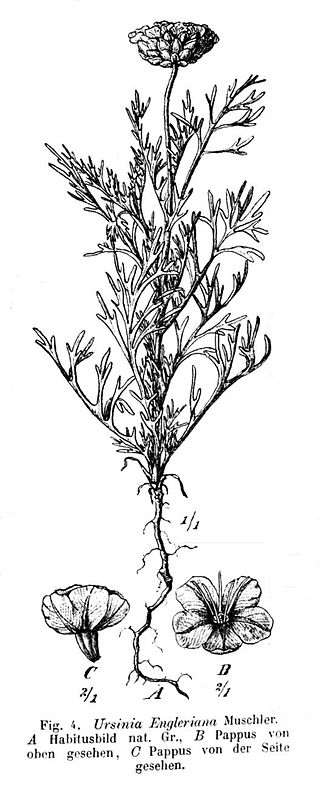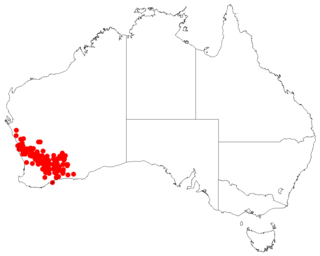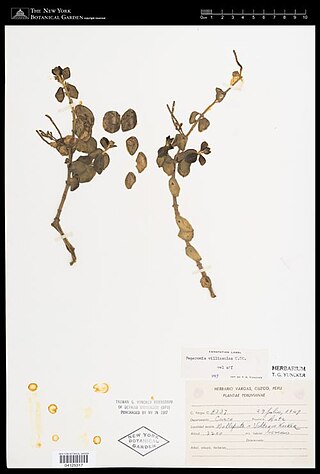Calycosiphonia is a genus of flowering plants in the family Rubiaceae. It is native to tropical Africa from Ivory Coast to Sudan to Mozambique.
Planaltoa is a genus of flowering plants in the tribe Eupatorieae within the family Asteraceae.

Ursinia nana DC. is a Southern African annual herb belonging to the Daisy family of Asteraceae. It is a pioneer plant of disturbed ground and usually grows to a height of only 30 cm. It flowers throughout the rainy season and, in mild weather with late rains, well into the autumn months. The leaves are deeply laciniate and bunched. In his 1912 contribution to Botanische Jahrbücher für Systematik, Pflanzengeschichte und Pflanzengeographie, the enigmatic German botanist Reinhold Conrad Muschler describes Ursinia engleriana, found near Okahandja in South West Africa, as a new species of African composite. Later this was considered to be the same as Ursinia nana described by de Candolle. Muschler praised the species as being extremely ornamental.
Namaquanula is a plant genus in the Amaryllidaceae, found only in Namibia and the Cape Province of South Africa. There are 2 recognized species:
Woodia is a genus in the family Apocynaceae first described as a genus in 1894. It is native to southern Africa
- Woodia mucronataN.E.Br.
- Woodia singularisN.E. Br.
- Woodia verruculosaSchltr.

Stigmatorhynchus is a genus of plants in the Apocynaceae, first described as a genus in 1913. It is native to Africa.
- Stigmatorhynchus hereroensisSchltr. - Damaraland region of Namibia
- Stigmatorhynchus steleostigma(K. Schum.) Schltr. - Somalia
- Stigmatorhynchus umbelliferus(K. Schum.) Schltr. - Tanzania

Stenostelma is a genus of plants in the family Apocynaceae, first described as a genus in 1894. It is native to South Africa.
- Stenostelma capenseSchltr. - Northern Cape Province
- Stenostelma carinatum(Schltr.) Bullock - KwaZulu-Natal
- Stenostelma corniculatum(E. Mey.) Bullock - Eastern Cape Province
- Stenostelma umbelluliferum(Schltr.) Bester & Nicholas - Gauteng Province
Pentacyphus is a genus of plants in the family Apocynaceae, first described as a genus in 1906. It is native to South America.
- Pentacyphus andinus(Ball) Liede – Peru
- Pentacyphus lehmannii(Schltr.) Liede – Colombia, Ecuador
Schistonema is a group of plants in the family Apocynaceae first described as a genus in 1906. It contains only one known species, Schistonema weberbaueri, native to the Cajamarca region of Peru.
Kania is a genus of evergreen shrubs in the myrtle family Myrtaceae described as a genus in 1914. The entire genus is native to New Guinea and the Philippines.
Pentarhopalopilia is a genus of plants in the family Opiliaceae described as a genus in 1987.
Baeckea grandis is a species of flowering plant in the family Myrtaceae and is endemic to the south-west of Western Australia. It is an ascending to low-lying shrub that typically grows to a height of 0.1 to 0.5 metres and blooms between September and December producing pink and white flowers. Found on sand-plains and hills in the Mid West and northern Wheatbelt regions of Western Australia, it grows in sandy and lateritic soils.

Paul Hubertus Hiepko - was a German botanist and journals editor.
Baeckea staminosa is a species of flowering plant in the family Myrtaceae and is endemic to the south-west of Western Australia. It is a spreading shrub that typically grows to a height of 25 cm (9.8 in) and is found in wetlands in the Geraldton Sandplains biogeographic region.

Mirbelia depressa is a species of flowering plant in the family Fabaceae and is endemic to Western Australia. It is an erect or spreading, prickly shrub that typically grows to a height of 0.15–1 m high and has yellow or orange and reddish-brown flowers from August to October. It was first formally described in 1904 by Ernst Georg Pritzel in the Botanische Jahrbücher für Systematik, Pflanzengeschichte und Pflanzengeographie. The specific epithet (depressa) means "pressed down", referring to the low habit of this species. This mirbelia grows on sandplains and is widespread in the Avon Wheatbelt, Coolgardie, Esperance Plains, Geraldton Sandplains, Gibson Desert, Great Victoria Desert, Mallee, Murchison and Yalgoo and bioregions of Western Australia, and is listed as "not threatened" by the Government of Western Australia Department of Biodiversity, Conservation and Attractions.

Leucopogon cinereus is a species of flowering plant in the heath family Ericaceae and is endemic to the south-west of Western Australia. It is an erect, compact shrub that typically grows to a height of 0.3–1 m and has white flowers from August to October. It was first formally described in 1904 by Ernst Georg Pritzel in Botanische Jahrbücher für Systematik, Pflanzengeschichte und Pflanzengeographie from specimens collected on rocky hills near Gillingarra. The specific epithet (cinereus) means "grey", referring to the colour of the young stems and leaves.

Leucopogon dielsianus is a species of flowering plant in the heath family Ericaceae and is endemic to the south-west of Western Australia. It was first formally described in 1904 by Ernst Georg Pritzel in Botanische Jahrbücher für Systematik, Pflanzengeschichte und Pflanzengeographie from specimens collected near Tammin. The specific epithet (dielsianus) honours Ludwig Diels.

Leucopogon hamulosus is a species of flowering plant in the heath family Ericaceae and is endemic to the south-west of Western Australia. It was first formally described in 1904 by Ernst Georg Pritzel in Botanische Jahrbücher für Systematik, Pflanzengeschichte und Pflanzengeographie from specimens he collected near Mingenew. The specific epithet (hamulosus) means "having small hooks" referring to the tips of the leaves.

Leucopogon mollis is a species of flowering plant in the heath family Ericaceae and is endemic to the south-west of Western Australia. It is a slender, diffuse shrub that typically grows to a height of 0.3–1 m and has white, tube-shaped flowers. The species was first formally described in 1904 by Ernst Georg Pritzel in Botanische Jahrbücher für Systematik, Pflanzengeschichte und Pflanzengeographie from specimens collected on the summit of "Mount Mongerup" in the Stirling Range. The specific epithet (mollis) means "soft".

Peperomia villicaulis is a species of plant from the genus Peperomia. It was first described by Casimir de Candolle and published in the book "Botanische Jahrbücher für Systematik, Pflanzengeschichte und Pflanzengeographie 40: 264. 1908".









